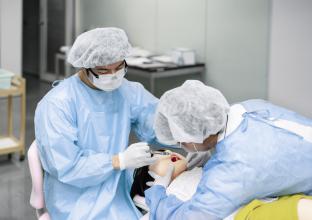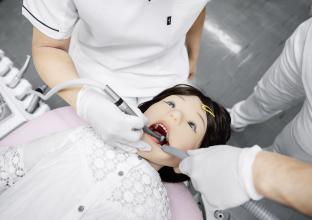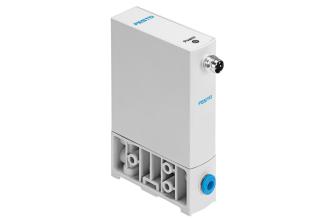
No longer afraid of the dentist
No one enjoys going to the dentist; young children even less so. To help future dentists and dental assistants deal with children during dental treatments, the Japanese company tmsuk has developed a humanoid robot that realistically simulates the behaviour of young children during these treatments, complete with fidgeting, flinching or closing the mouth. The dummy’s realistic movements are produced using proportional pressure regulators with piezo technology from Festo.
Hardly anyone reckons with that: during many dental treatments small children are harmed due to loss of blood pressure, shocks or unconsciousness – up to very critical physical conditions. It is therefore all the more important that the teaching offered to dentists and dental assistants prepares them for the restlessness and fear displayed by young children during a dental treatment. This makes a simulation robot more than practical, since it is not feasible to use living people for teaching dentistry and oral surgery.
Pneumatic robot
The Japanese company tmsuk has already introduced a number of service robots onto the market, such as transport robots and robots for caring elderly people. Like many classic robots, all of them are equipped with electric axes. Now the company is continuing its push forward into the field of medical simulation with teaching robots. The robot for simulating young children during dental treatments, called the Pedia_Roid, is 110 cm tall and weighs 23 kg, equivalent to a five-year-old.
The Pedia_Roid is pneumatic, since the students and trainees sometimes have to hold the robotic dummy’s limbs during treatment simulations. This could damage the gear unit and spindles of electric drives. In this case, pneumatics is more robust and flexible than electric drive technology.
Smooth movements with piezo technology
The smooth, lifelike movements are only possible with piezo technology, which is the basis for the proportional pressure regulators VEAA and VEAB from Festo used in the robot. They control most of the robot’s 24 pneumatic cylinders that deliver the deceptively realistic movements of the arms, legs and fingers as well as the mouth, eyelids and irises. Silent and with low energy consumption, the proportional pressure regulators make it possible to simulate the human-like behaviours. Unlike classic pneumatic solenoid valves, they do not make any clicking sounds when they switch since the bender actuator moves freely and without any impact noises.
“We would not have been able to realise this humanoid robot without the piezo technology employed by Festo in the proportional pressure regulators,” explains Yusuke Ishii, Director of tmsuk. The proportional pressure regulators VEAA/VEAB are 3/3-way valves with a pressure sensor and control electronics. Compared with solenoid valves, proportional valves with piezo technology require virtually no energy to maintain an active state thanks to their capacitive principle. The piezo valve operates like a capacitor: it needs energy only at the start in order to charge the piezoceramics. No further energy is needed to maintain its state. As a result, the valves do not heat up either. Piezo valves consume up to 95% less energy than solenoid valves, which permanently require an electrical current.
Long service life, small footprint
The design of the proportional pressure regulators VEAA/VEAB makes them resistant to wear and capable of achieving a high number of cycles. The VEAA and VEAB offer huge benefits for pressure regulation applications with low to very low air consumption involving cylinders, as well as for applications requiring a high dynamic response such as the Pedia_Roid robots. The compact design of these proportional valves combines space-saving installation with a low intrinsic weight.
Thus the world’s first 50 robots for teaching dental medicine are in production planning before being sent out to be used in universities and colleges in Japan, South East Asia and in the Middle East. Other regions of the world will follow...
About tmsuk:
The Japanese tmsuk company limited has tasked itself with developing service robots to assist people in the medical environment as well as in disaster zones. Based on the island of Kyushu, the most southerly of Japan’s four main islands, the company was established in 2000 and has 24 employees as well as a subsidiary company in Taiwan.
Festo is a global player and an independent family-owned company with headquarters in Esslingen am Neckar, Germany. Festo has set standards in industrial automation technology and technical education ever since its establishment, thereby making a contribution to sustainable development of the environment, the economy and society. The company supplies pneumatic and electrical automation technology to 300,000 customers of factory and process automation in over 35 industries. Digitalization, AI and the LifeTech sector with medical technology and laboratory automation are becoming increasingly important. The products and services are available in 176 countries. With about 20,600 employees in over 250 branch offices in around 60 countries worldwide, Festo achieved a turnover of around €3.45 billion in 2024. More than 8% of this turnover is invested in research and development. In this learning company, 1.5 % of turnover is invested in basic and further training. Festo Didactic SE is a leading provider of technical education and training and offers its customers worldwide comprehensive digital and physical learning solutions in the industrial environment.



